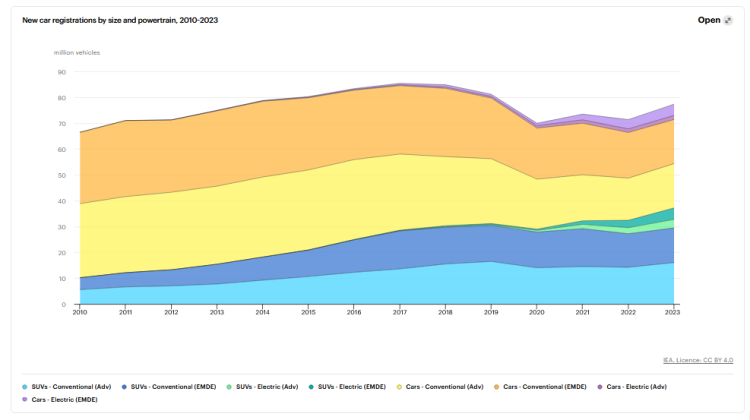By Laura Cozzi, Director, Sustainability, Technology and Outlooks and Apostolos Petropoulos, Energy Modeller
The large, heavy passenger vehicles were responsible for over 20% of the growth in global energy-related CO2 emissions last year
SUVs accounted for 48% of global car sales in 2023, reaching a new record and further strengthening the defining automobile trend of the early 21st century - the shift towards ever larger and heavier cars. There are various driving forces behind this trend, from the appeal of SUVs as a status symbol and their potential enhancements in comfort, to the marketing strategies of leading automakers.

In advanced economies, SUV sales reached around 20 million last year, surpassing a market share of 50% for the first time. This preference for larger vehicles extends to emerging and developing economies, too, where the share of SUVs in total car sales mirrors this trend. Today, more than one in four cars on the road worldwide are SUVs, the majority of which are conventional internal combustion engine (ICE) vehicles. While only 5% of SUVs currently on the road are electric, they account for a growing share of electric car sales. In 2023, more than 55% of new electric car registrations were SUVs.
If SUVs were a country, they would be the world's fifth largest emitter of CO2
SUVs weigh 200-300 kg more than an average medium-sized car, and typically take up nearly 0.3 m2 more space - emitting roughly 20% more carbon dioxide (CO2) emissions. The trend towards heavier and less fuel-efficient cars increases energy demand, including oil and electricity use, as well as demand for basic metals and critical minerals needed for battery production. Over the course of 2022 and 2023, global oil consumption directly related to SUVs rose by a total of over 600 000 barrels per day, accounting for more than a quarter of the overall annual growth in oil demand.









